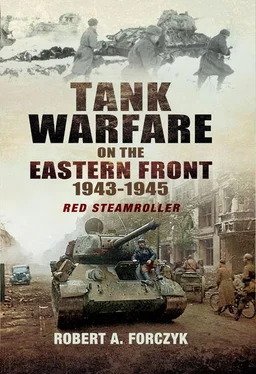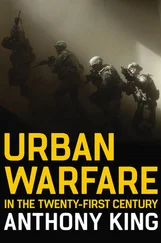Between 16–17 January, Heeresgruppe B’s front became unglued and all the Axis forces in this sector were in retreat. Gruppe Cramer was briefly surrounded at Ostrogozhsk but he fought his way through Soviet lines with his Sturmgeschütz blasting a path clear; both battalions suffered heavy losses and would have to be sent back to Germany for rebuilding. On 17 January, Koptsov’s 15th Tank Corps linked up with some of 40th Army’s advance units near Alekseevka, cutting off the Italian Alpine Corps and thousands of retreating German and Hungarian troops. A Soviet tank battalion from 12th Tank Corps rushed into Rossosh and caught the Italians by surprise, but two German Marder IIIs arrived and knocked out a number of Soviet tanks, causing them to withdraw. Nevertheless, Rybalko’s 3rd Tank Army had virtually closed the door behind the Italians and he focused his attention westward toward the rail junction at Valuyki, which he sent Sokolov’s cavalry to capture. Meanwhile, Hitler ordered von Weichs to stand fast – he promised help was on the way – and Heeresgruppe B ordered the Italian Alpine Corps to maintain its positions on the Don. Realizing that they were already isolated by Rybalko’s advance, the Italians ignored these nonsensical orders and began marching westward across the snow.
The rest of the campaign from 18–27 January was essentially an Axis retreat and a slow Soviet pursuit. The remnants of Gruppe Cramer and the Hungarians fell back to the Oskol River where they managed to stop the 40th Army’s advance for a while. Hitler did indeed transfer the Großdeutschland Division from Heeresgruppe Mitte to reinforce the line on the Oskol, but this was still a drop in the ocean. Amazingly, the Italian Alpine Corps fought its way out of encirclement by 29 January but all three of its divisions were ruined and it suffered over 30,000 casualties. In the south, the collapse of XXIV Panzerkorps forced the Axis forces to abandon Starobelsk and retreat behind the Donets River; this unfortunate formation lost two more commanders between 20–21 January. [6]The XXIV Panzerkorps was reduced to about 2,500 troops and both the 27.Panzer-Division and 385.Infanterie-Division were disbanded soon afterwards. Altogether, the Hungarians had suffered about 100,000 casualties and the Italians 30–40,000. Rybalko’s army had won a significant operational victory, in conjunction with the 40th Army, which knocked both the Italian 8th Army and the Hungarian 2nd Army out of action and thereby created a 190km-wide gap in Heeresgruppe B’s front; von Weichs could not plug all the gaps and his new line on the Oskol River was little more than a speed bump.
Rybalko’s 3rd Tank Army was worn down by the rapid advance and its forward brigades were short on fuel and ammunition, but it was flush with victory. Every German armoured unit involved in opposing the Soviet offensive was either destroyed, dispersed or otherwise rendered combat ineffective – Heeresgruppe B was virtually stripped of armour. Although the two-week long Soviet Ostrogozhsk–Rossosh Offensive is not well known today, it represents a clear indicator that Operation Uranus was not a fluke in November 1942 and that the Red Army was learning how to conduct effective combined arms warfare. The Soviet use of Maskirovka in order to achieve operational surprise, as well as massing fires and using manoeuvre to exploit a breakthrough, were professionally executed. However, the operation also indicated lingering Soviet problems with logistical sustainment in mobile operations and Rybalko’s tank army was unable to maintain its combat power for long due to shortages.
Heeresgruppe Mitte’s trials at Rzhev and Velikiye Luki, 1 January–1 March 1943
For the period January–February 1943, most histories of the Eastern Front tend to focus on the Soviet offensives across the Don and the German counter-offensive at Kharkov, while ignoring the rest of the Eastern Front. In fact, the Soviet Winter Offensive of 1942–43 was across the board and inflicted significant damage on the Ostheer in both Heeresgruppe Mitte and Heeresgruppe Nord. More than half of the Ostheer’s casualties in January 1943 occurred in the northern and central sectors of the front, not the south. [7]Indeed, had the Red Army allowed these other sectors to remain relatively quiet, von Manstein and von Weichs would have received considerably more reinforcements from these commands. Despite the defeat of Zhukov’s Operation Mars in November– December 1942, both the Western and Kalinin Fronts continued to pound on Generaloberst Walter Model’s 9.Armee in the Rzhev salient during January 1943, which necessitated Heeresgruppe Mitte keeping five Panzer-Divisionen and three Sturmgeschütz-Abteilungen in this hard-pressed sector. Only the Großdeutschland Division was transferred south. Eventually, Model was able to convince Hitler that it was no longer worth the sacrifice to hold the Rzhev salient and that the resources required to hold the salient could be better used in the south. On 6 February, Hitler finally authorized Model to evacuate the Rzhev salient, although the operation would not begin until 1 March. Consequently, the mass of Heeresgruppe Mitte’s panzers and assault guns remained in the Rzhev sector throughout the winter campaign.
Another crisis for Heeresgruppe Mitte was unfolding around the city of Velikiye Luki, near the boundary with Heeresgruppe Nord. General-major Kuzma N. Galitski’s 3rd Shock Army from the Kalinin Front had encircled the city on 27 November 1942, trapping 8,000 German troops from the 83.Infanterie-Division and other units. The city was heavily fortified and the Luftwaffe could provide aerial supplies to this small force for a time, but it was clear that a relief operation needed to be mounted. Generalleutnant Erich Brandenger’s 8.Panzer-Division was equipped with only 32 tanks, mostly obsolete Pz 38(t) light tanks, but it was assigned to Gruppe Chevallerie to mount a relief operation. [8]Hauptmann Horst Krafft’s Sturmgeschütz-Abteilung 185 was also provided to the relief operation; as an experiment, the 3.Batterie in this battalion was entirely equipped with the StuH 42 armed with the 10.5cm howitzer. {33} However, two hastily-assembled relief attempts in late November and mid-December 1942 failed with heavy losses, including all the StuH 42 assault guns and many of the Pz 38(t) tanks. Galitski’s 3rd Shock Army was supported by vastly more and better armour, including General-major Ivan P. Korchagin’s 2nd Mechanized Corps, the 13th Guards Tank Regiment equipped with KV-1 heavy tanks and two other tank brigades and five other tank regiments. Korchagin was a veteran tank officer and his corps was equipped with over 100 T-34 tanks and 70 T-70 light tanks – in itself more than a match for Brandenberger’s scrap-heap Panzer-Division. Consequently, it came as no surprise that the German relief efforts failed and Galitski’s infantry and artillery proceeded to reduce the encircled garrison in Velikiye Luki. However, Soviet efforts to send tanks into the city proved costly, due to the effectiveness of the German Panzerjägers in the wrecked city streets.
By New Year, Velikiye Luki had been surrounded for five weeks and pounded into rubble; it was clear that the garrison could not hold out much longer. Von Chevallerie was resolved to make one more relief attempt and was provided a handful of additional units, including the I./Panzer-Regiment 15 with 37 tanks (including 28 Pz III Ausf L/M and 3 Pz IV Ausf G). This battalion belonged to the 11.Panzer-Division and had been designated to return to Germany to re-equip with the new Panther tank at Grafenwöhr but had been diverted to Heeresgruppe Mitte to save the Velikiye Luki garrison. On 4 January, von Chevallerie launched Operation Totila and was able to batter his way to within 9–10km of the city, before the effort bogged down in the face of determined Soviet resistance. One German panzer platoon leader, Oberfeldwebel Gerhard Brehme, distinguished himself during the relief attempt by knocking out eight Soviet tanks; like a number of veteran German panzer NCOs, Brehme already had about 40 ‘kills’ over the past two years of combat. Nevertheless, the effort failed and Galitski’s troops overran the eastern part of the city.
Читать дальше








![John Stieber - Against the Odds - Survival on the Russian Front 1944-1945 [2nd Edition]](/books/405234/john-stieber-against-the-odds-survival-on-the-russian-front-1944-1945-2nd-edition-thumb.webp)



